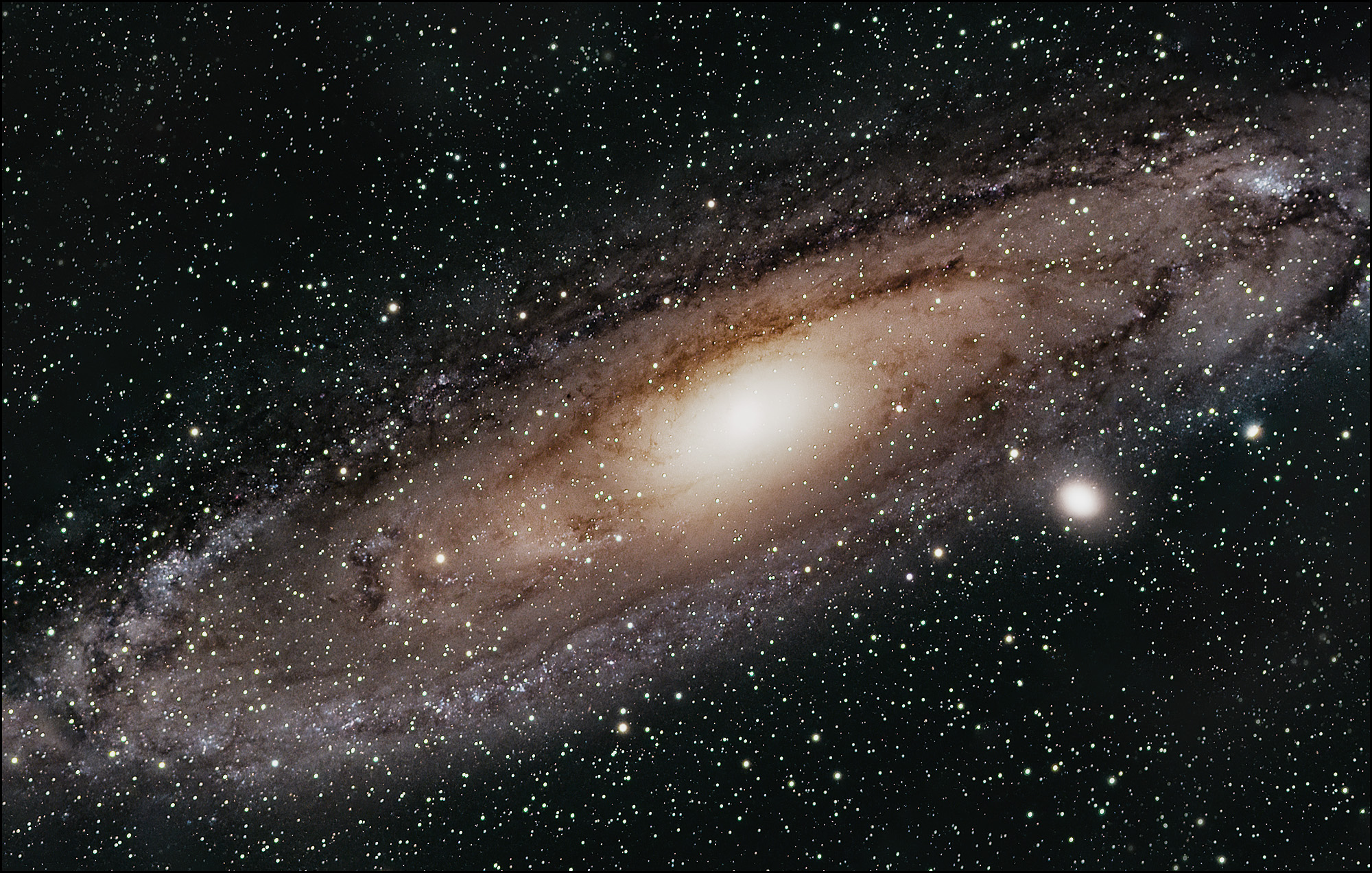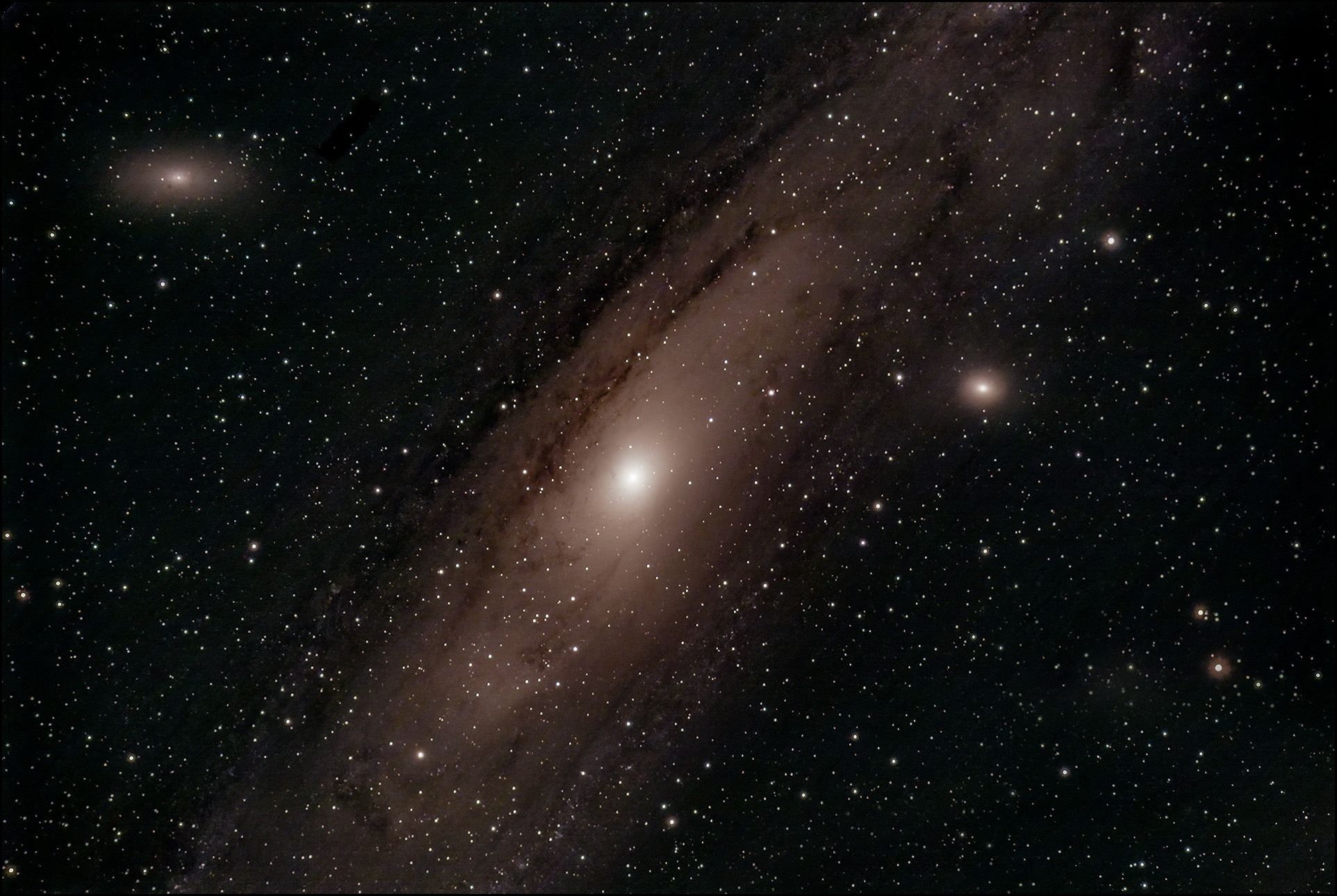This is phase 3 of my Andromeda Galaxy imaging. I took this near the top of Palomar Mountain, which isn't as dark as the desert but makes up for it with 5,000 feet of elevation.
Although my imaging session started out poorly, it ended up going very well. The sky was dark and clear; focus was good; the meridian flip executed without a hitch; I finally got a really good calibration on my guide camera; polar alignment was perfect; and autoguiding worked about as well as it can. The final image uses 47 stacked five-minute exposures
The main difference between this one and the phase two image is that the longer exposure time does a better job of showing the cloudy periphery around the core of the galaxy. It's a matter of opinion which one is the prettier photograph—I'd pick the phase two image—but the phase three picture is unquestionably sharper and shows much more detail.
This is my final image of Andromeda. Given my current level of skill, it's about as good as I can do, and I never planned to spend a lot of time on it in the first place. But with my basic skills now fairly complete, it's time to move on to other targets. The moon will keep me indoors for the next couple of weeks, but I should have something nice to show you three or four weeks from now.
UPDATE: In order to match the orientation of the other two photos, I initially flipped the phase 3 photo. That was a mistake, so I re-edited the image later and rotated it instead of flipping it. I also did the sharpening and de-noising more carefully, and toned down the color a bit. The star fields at top left and bottom right were artificially added after the rotation, which does no harm.




The October 2nd image is by far the best. And, I'm really impressed with your technical skills Kevin. Don't give up on deep space objects. I'm sure you have a lot of fans here.
Sick!
Astrophotography of the moon is also very aesthetic. No need to put the telescope away just because the moon is up.
+1
I agree!
The moon and planets are quite visually appealing. I imagine they present different challenges than very dim objects. But, I’m sure the brightness and maybe the motion complicate things. I’d love to see you master these challenges and your results.
They're all amazing. Spectacular!!
I dunno. Can see some of the blue Pop II stars, but they ought to be way brighter.
I don't know much about astronomy but in your images, just off the top edge of the galaxy near the center there is a linear group of stars that I presume is a consequence of multiple images. However, it seems strange that there would be something moving along with the galaxy in each image over several days. In the September images the linear group is somewhat left of the galaxy center but by October is now right of the galaxy center. This would seem to be something that is moving in relation to the galaxy quickly enough to create the linear sequence each time. Perhaps a comet?
Note that the images are flipped between 10/2 and 9/19. The two bright objects that are on the right on 9/19 are at the bottom left on 10/2.
I accidentally rotated my camera in the wrong direction for the final image, so I flipped it in order to have all three images look similar. Just a bit of anal behavior on my part. I wouldn't flip it if it were a standalone image.
Also, I experimented with the star reduction feature of my software. I don't think it turned out very well. I'll try again another time.
Which one of those is Jesus' house? Religion and religious people get ever more ridiculous with every picture from a telescope. Why do we even take them seriously?
Kevin, how do you keep your sensor cool with these 5 minute exposures? Do you have some secret...my camera gets hot as heck at anything over 30 or so seconds. I am just thinking you might have some trick....Best Wishes, Traveller
I use a cooled astrophotography camera!
Thank you! Not a criticism, but this helps explain how you achieve these absolutely stunning images of our Universe, really NASA level photography.
I look again and again and I think that Sept 19 is my favorite image...it is a little busier with another galaxy in the upper left...but all of them humble me and further show our (my) place in the Universe, capital U. Thanks again, I owe you...a debt I am happy to have.
Really great! Now do the planets!
My equipment can't do planetary photography. I've tried....
Stunning! So cool!
What Kevin is doing is called deep-sky astrophotography -- fairly dim targets, of which lots of large ones are available. (Andromeda is a bit over 3 degrees wide, or 6X the size of the full Moon.) For that, the big challenge is extracting signal from noise, which he's addressing via long exposures (hence the autoguiding) and lots of them.
Planets and the Moon, as noted above, are very bright sunlit objects. So S/N isn't such a problem...but planets are *tiny*, to the extent that atmospheric turbulence gets to be a real problem when you magnify them enough to make them out. The current state of the art in Earthbound amateur planet photography is to use a scope of long focal length (~ 2X Kevin's) and shoot video. Then software combs through the video looking for moments when the atmosphere was relatively quiet. The shorter the exposure (i.e. higher the frame rate), the likelier it will find some.
Kevin's got a great deep-sky rig -- a medium-focal-length scope that admits a lot of light, a camera with a nice big sensor and high sensitivity with low noise, and autoguiding gear. Planets need a much longer scope, and a camera with a tiny sensor that can sling a hundred or more frames per second.
fewayne, Thanks for the quick tutorial. Much appreciated.